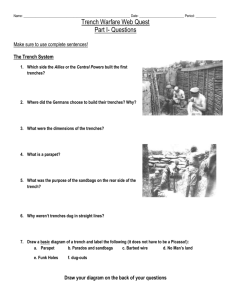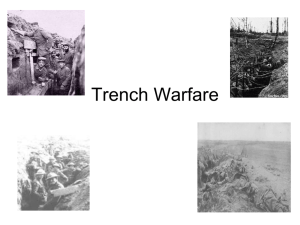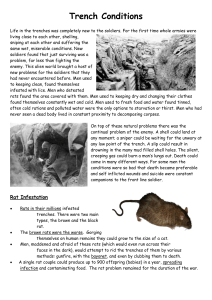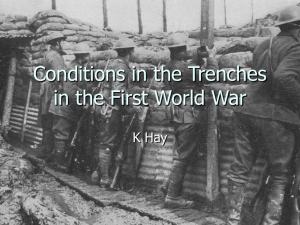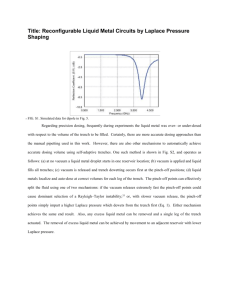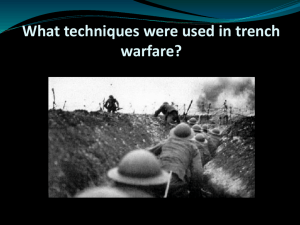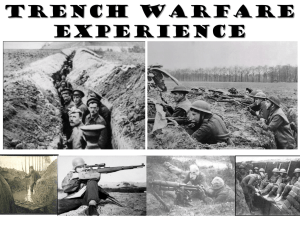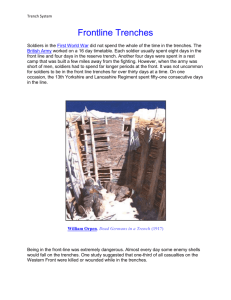Life in the Trenches
advertisement
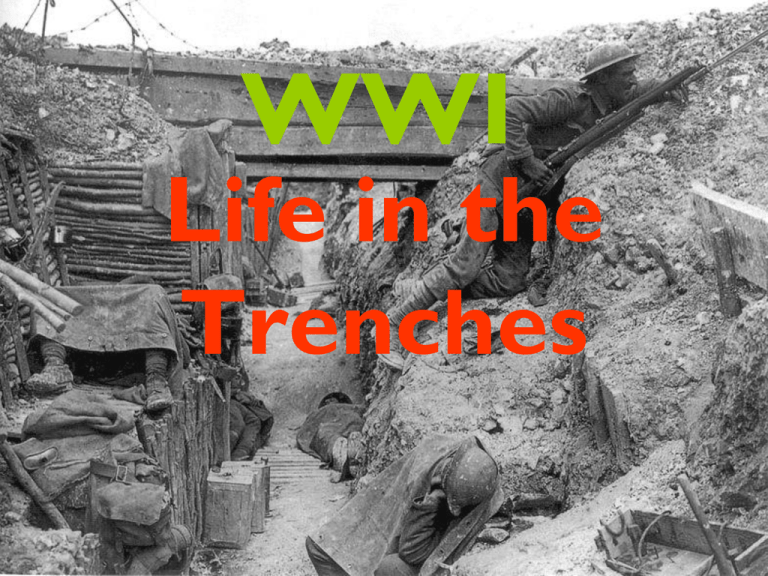
WWI Life in the Trenches The Trench System • Trenches were often built in angles with many dead ends called traverses to confuse the enemy, should they stage a raid. • Short trenches called saps were dug into No Man’s Land in order to be able to hear the enemy Problems Facing Troops in the Trenches A day in the life... • Trench cycle: Should be 6 days on frontlines, 6 days on reserve and 20 days rest Reality: dependant on necessity (severity of the fighting) and location Per year: 70 days on the front, 30 in support, 120 in reserve. ONLY 70 DAYS SPENT IN REST Attacking from the Trenches “An officer wanted to know how near the enemy was, and would not believe Bird when he told him. He decided to take a quick look over the parapet. Bird shouted, ‘Don’t!’ But he was too late. A bullet went right through the officer’s head.” -Will R. Bird, writing about a German sniper Life in the Trenches Life in the Trenches “Whilst asleep during the night, we were frequently awakened by rats running over us. When this happened too often for my liking, I would lie on my back and wait for a rat to linger on my legs; then violently heave my legs upwards, throwing the rat into the air. Occasionally, I would hear a grunt when the rat landed on a fellow victim.” (R. L. Venables) “The water in the trenches through which we waded was alive with a multitude of swimming frogs. Red slugs crawled up the side of the trenches and strange beetles with dangerous looking horns wriggled along dry ledges and invaded the dugouts, in search of the lice that infested them.” (unknown journalist) Diseases in the Trenches Trench Foot •Trench foot is a medical condition caused by prolonged exposure of the feet to damp, unsanitary and cold conditions – it can cause the flesh between and around the toes to rot •If trench foot was left untreated, it could become gangrenous and need to be amputated. Trench Foot “If you have never had trench foot described to you, I will explain. Your feet swell to two to three times their normal size and go completely dead. You can stick a bayonet into them and not feel a thing. If you are lucky enough not to lose your feet and the swelling starts to go down, it is then that the most indescribable agony begins. I have heard men cry and scream with pain and many have had to have their feet and legs amputated. I was one of the lucky ones, but one more day in that trench and it may have been too late.” (Harry Roberts) Soldiers put Whale Oil on their feet in an attempt to prevent Trench Foot. Left: German powder Right: American powder Bottom: “housewife” Duckboards •Most of the land on the Western Front was only a couple of feet above sea level. •As soon as soldiers began to dig trenches they would find water just below the surface. •Constantly standing in water caused trench foot and other ailments. •In an attempt to alleviate the problem, wooden planking, known as duckboards, were placed at the bottom of trenches and across other areas of muddy or waterlogged ground. Trench Mouth •Trench mouth is a bacterial infection of the gums that results from poor oral hygiene, stress and smoking •Symptoms are: bleeding gums, ulcers and gradual decomposition of the jaw •When not treated, trench mouth can spread to the cheeks, lips or jawbone seriously damaging bone and gum tissue. •Trench mouth can also enter the blood stream and spread to other parts of the body. •Trench mouth makes eating and swallowing food painful, it often results in weight loss Trench Fever • Trench Fever is a disease spread by body lice carrying bacteria •Soldiers would catch this disease by being bitten by “infected” lice •Symptoms: high fever, headache, sore muscles, and outbreaks of skin lesions Life in the Trenches • Soldiers, after about a month in the trenches, were allowed to go to the rear for some sleep, to clean up, and be in a dry place At the age of 92, Arthur Savage was asked about his memories of life on the Western Front. “My memories are of sheer terror and the horror of seeing men sobbing because they had trench foot that had turned gangrenous. They knew they were going to lose a leg. Memories of lice in your clothing driving you crazy. Filth and lack of privacy. Of huge rats that showed no fear of you as they stole your food rations. And cold deep wet mud everywhere. And of course, corpses. I'd never seen a dead body before I went to war. But in the trenches the dead are lying all around you. You could be talking to the fellow next to you when suddenly he'd be hit by a sniper and fall dead beside you. And there he’d stay for days.” Otto Dix: War Art Trenches 1917 Dance of Death 1917 Self Portrait As a Target 1915 Otto Dix: War Art Shell Hole Flowers Shellshock • One of the tremendous stresses from being in trench warfare was the constant firing of weapons and artillery and threat of death • This became known as Shellshock, and soldiers would have nervous breakdowns and have to be hospitalized when they returned home • Video: Shell Shock and the Case of Harry Farr “Go out and meet death bravely” Video Clip Canada: A People’s History (DVD) Ordeal By Fire Chapter 4 (~9 mins)

